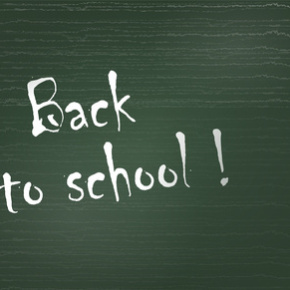This week, television shows, Hallmark cards and advertisements tell us repeatedly that Valentine’s Day is about celebrating love–romantic love, familial love,  friendship love. I even saw a Valentine’s Day card for your dog! It can all be a bit overwhelming, especially if you are feeling less loving than the commercials suggest you should be. I would like to suggest that you can transform this day into something meaningful for you and your ADHD son or daughter by being authentic and acknowledging what is positive in your relationship. Often we are so busy with our chaotic lives that we neglect to notice and name things that are going well and move quickly onto what isn’t working. While it is great to give and receive funny cards and candy on Valentine’s Day, it can also feel wonderful to share and name things that family members like and appreciate about each other. It might sound corny but such conversations or written words, however brief, can have lasting effects. Taking the time to add your own comments about a positive behavior or attitude on a card or at a meal will show that you really see your child’s efforts to do well and encourage more of them. Even teenagers who can seem indifferent or combative to you actually listen to your positive feedback. The trick is keeping your
friendship love. I even saw a Valentine’s Day card for your dog! It can all be a bit overwhelming, especially if you are feeling less loving than the commercials suggest you should be. I would like to suggest that you can transform this day into something meaningful for you and your ADHD son or daughter by being authentic and acknowledging what is positive in your relationship. Often we are so busy with our chaotic lives that we neglect to notice and name things that are going well and move quickly onto what isn’t working. While it is great to give and receive funny cards and candy on Valentine’s Day, it can also feel wonderful to share and name things that family members like and appreciate about each other. It might sound corny but such conversations or written words, however brief, can have lasting effects. Taking the time to add your own comments about a positive behavior or attitude on a card or at a meal will show that you really see your child’s efforts to do well and encourage more of them. Even teenagers who can seem indifferent or combative to you actually listen to your positive feedback. The trick is keeping your  comments “short and sweet”: you have to grab their attention, be succinct and speak genuinely or your ADHD son or daughter will smell a rat and stop listening immediately. Here are my tips for a Valentine’s Day with REAL heart for you and your ADHD child: 1. Talk to your family and set a time for Valentine’s Day cards, gifts or exchanges. It doesn’t have to be a big deal; just a time when everyone can be together. Make an agreement about the general plan: “We will be giving cards and not gifts.” Or, “We will give gifts that are homemade only.” Or, “No cards, no gifts, only chocolate.” Do what seems natural for your family. Participation is not mandatory but attendance is. 2. If you give cards, write a few things that your son or daughter does that you like. BE SPECIFIC. “I like how you hum when you eat your food.” “I love when you give me a hug before bed.” “I appreciate when you clear your plate after dinner.” “I like your sense of style, even though it’s different from mine.” If you are doing a verbal exchange, plan what you have to say so you it doesn’t seem like you are making things up at the last minute. 3. When you get together as a family, share your cards or comments without elaborating or dwelling on them. Your ADHD son or daughter has a limited attention span and we want this to be fun. Lingering on topics, even if they are good ones, promotes distractedness. Reciprocity and connection, however brief, are the goals here. Enjoy an authentic Valentine’s Day!
comments “short and sweet”: you have to grab their attention, be succinct and speak genuinely or your ADHD son or daughter will smell a rat and stop listening immediately. Here are my tips for a Valentine’s Day with REAL heart for you and your ADHD child: 1. Talk to your family and set a time for Valentine’s Day cards, gifts or exchanges. It doesn’t have to be a big deal; just a time when everyone can be together. Make an agreement about the general plan: “We will be giving cards and not gifts.” Or, “We will give gifts that are homemade only.” Or, “No cards, no gifts, only chocolate.” Do what seems natural for your family. Participation is not mandatory but attendance is. 2. If you give cards, write a few things that your son or daughter does that you like. BE SPECIFIC. “I like how you hum when you eat your food.” “I love when you give me a hug before bed.” “I appreciate when you clear your plate after dinner.” “I like your sense of style, even though it’s different from mine.” If you are doing a verbal exchange, plan what you have to say so you it doesn’t seem like you are making things up at the last minute. 3. When you get together as a family, share your cards or comments without elaborating or dwelling on them. Your ADHD son or daughter has a limited attention span and we want this to be fun. Lingering on topics, even if they are good ones, promotes distractedness. Reciprocity and connection, however brief, are the goals here. Enjoy an authentic Valentine’s Day! 
Author: artefact_admin
Trouble starting something? Get MOTIVATED! (RECYCLED 9/22/2021)
 Have you ever asked your ADHD son to start his homework over and over and still he doesn’t sit down to do it? Even if he is failing the class and it means he won’t be able to play on the basketball team? Even if it means that he won’t be able to go out on Friday night? It’s hard not to become immensely frustrated with him and his behavior at this point. Most likely, he can’t start his homework because he lacks motivation-–either internal or external–which would get him going. How can parents assist their children in developing motivation?
Have you ever asked your ADHD son to start his homework over and over and still he doesn’t sit down to do it? Even if he is failing the class and it means he won’t be able to play on the basketball team? Even if it means that he won’t be able to go out on Friday night? It’s hard not to become immensely frustrated with him and his behavior at this point. Most likely, he can’t start his homework because he lacks motivation-–either internal or external–which would get him going. How can parents assist their children in developing motivation?  Let’s first reflect on ourselves and what helps us do things. It’s easy to do something you like, whether it’s reading an engrossing novel or playing tennis on a sunny day. It is MUCH harder to do something that you don’t like such as folding laundry or taking out the trash. When a task is fundamentally unrewarding or uninteresting, we are not very compelled to do it. We lack internal motivation. When a task doesn’t have meaningful deadlines or immediate consequences to get us started (i.e. your boss expects the report tomorrow), it lacks external motivation. In both cases, we have to find something to get us going and our adult brains rely on fully matured frontal lobes to do so.
Let’s first reflect on ourselves and what helps us do things. It’s easy to do something you like, whether it’s reading an engrossing novel or playing tennis on a sunny day. It is MUCH harder to do something that you don’t like such as folding laundry or taking out the trash. When a task is fundamentally unrewarding or uninteresting, we are not very compelled to do it. We lack internal motivation. When a task doesn’t have meaningful deadlines or immediate consequences to get us started (i.e. your boss expects the report tomorrow), it lacks external motivation. In both cases, we have to find something to get us going and our adult brains rely on fully matured frontal lobes to do so.  ADHD children and teens have not yet developed the executive functioning skills to overcome poor focus, disinterest or boredom to get unpleasant tasks done. They often do not possess the strategies or solutions to address either internal or external motivation deficits. If something seems unappealing, they turn away from it–even if the consequences are serious. Most kids have to rely on external rewards to rouse themselves; internal motivation, and the satisfaction a person receives when a dreaded task is completed, comes later– in early adulthood. So children and teens need help from adults in their lives to create external rewards that are both meaningful and encouraging. Here are some tips on how you can create effective external rewards that will MOTIVATE your son or daughter: 1. Talk about the concept of external motivation. Most ADHD children and teens will acknowledge when they struggle with focusing and what tasks lack inherent interest or value for them. Ask what has assisted them in doing such things in the past and what would entice them to do them now. 2. Decide in advance with your child what the rewards will be for finishing something that is difficult to do. For example, if your son finishes his history project on time, maybe he can go out for pizza with his friends. Or, if he works for 30 minutes, he can earn 10 minutes of social media or music time. Do not remove the agreed upon reward if he engages in a separate behavior that you don’t like. If he earned the reward for doing the agreed-upon activity, then he should have it.
ADHD children and teens have not yet developed the executive functioning skills to overcome poor focus, disinterest or boredom to get unpleasant tasks done. They often do not possess the strategies or solutions to address either internal or external motivation deficits. If something seems unappealing, they turn away from it–even if the consequences are serious. Most kids have to rely on external rewards to rouse themselves; internal motivation, and the satisfaction a person receives when a dreaded task is completed, comes later– in early adulthood. So children and teens need help from adults in their lives to create external rewards that are both meaningful and encouraging. Here are some tips on how you can create effective external rewards that will MOTIVATE your son or daughter: 1. Talk about the concept of external motivation. Most ADHD children and teens will acknowledge when they struggle with focusing and what tasks lack inherent interest or value for them. Ask what has assisted them in doing such things in the past and what would entice them to do them now. 2. Decide in advance with your child what the rewards will be for finishing something that is difficult to do. For example, if your son finishes his history project on time, maybe he can go out for pizza with his friends. Or, if he works for 30 minutes, he can earn 10 minutes of social media or music time. Do not remove the agreed upon reward if he engages in a separate behavior that you don’t like. If he earned the reward for doing the agreed-upon activity, then he should have it.  3. Remember, (as I have written about in previous blogs) Most ADHD kids and teens have a great deal of difficulty starting something unpleasant because the task seems too large. Break it down into smaller components with timed rest periods during which your son or daughter can engage in a desired activity. Let’s say, for example, your 10 year old daughter’s room is a mess and you want her to pick it up. Think realistically together with her about how long she can actually work before she gets distracted, let’s say 15 minutes. Then, set up 3 15 minute work periods with 5 minute movement, snack or bathroom breaks. Remember that she may need help figuring out where to begin or she may want you to stay in her room and guide her through the process. Your support can be a key to her success. Good luck with your efforts and let’s get started!!
3. Remember, (as I have written about in previous blogs) Most ADHD kids and teens have a great deal of difficulty starting something unpleasant because the task seems too large. Break it down into smaller components with timed rest periods during which your son or daughter can engage in a desired activity. Let’s say, for example, your 10 year old daughter’s room is a mess and you want her to pick it up. Think realistically together with her about how long she can actually work before she gets distracted, let’s say 15 minutes. Then, set up 3 15 minute work periods with 5 minute movement, snack or bathroom breaks. Remember that she may need help figuring out where to begin or she may want you to stay in her room and guide her through the process. Your support can be a key to her success. Good luck with your efforts and let’s get started!!
Stop reacting and start responding!
 It’s been a long day and you finally make it home from work with a car full of groceries which have to be unpacked and then, somehow, magically transformed into a tasty and nutritious meal. You trudge into the house, bags in each hand, and your ADHD son rushes towards you, waving a pink piece of paper in your face. “You need to sign this so I can go on the field trip on Friday. It’s really important, my teacher said so. Can you sign it now?” You are amazed that he not only can’t see that you have no hands to sign anything but that he also doesn’t offer to take one of the grocery bags and help you. You can feel yourself about to lose it. What should you do? You can react and and shout at him, “What are you doing? Can’t you see that my hands are full?” In all likelihood, you will get a bigger reaction in return. OR, you can respond by saying, “Hey, I can see this is important but my arms are full. Why don’t you give me a hand and then we can take care of it right away?” By doing this second option, you will probably avoid a blow-out and maybe even get some cooperation along the way.
It’s been a long day and you finally make it home from work with a car full of groceries which have to be unpacked and then, somehow, magically transformed into a tasty and nutritious meal. You trudge into the house, bags in each hand, and your ADHD son rushes towards you, waving a pink piece of paper in your face. “You need to sign this so I can go on the field trip on Friday. It’s really important, my teacher said so. Can you sign it now?” You are amazed that he not only can’t see that you have no hands to sign anything but that he also doesn’t offer to take one of the grocery bags and help you. You can feel yourself about to lose it. What should you do? You can react and and shout at him, “What are you doing? Can’t you see that my hands are full?” In all likelihood, you will get a bigger reaction in return. OR, you can respond by saying, “Hey, I can see this is important but my arms are full. Why don’t you give me a hand and then we can take care of it right away?” By doing this second option, you will probably avoid a blow-out and maybe even get some cooperation along the way.  The big difference between reacting and responding is how you manage yourself. Did you ever have one of those moments when you say something in frustration and wish that you could suck it back inside to make it go away? We all do! Most likely, those words are part of a knee-jerk reaction–a time when your emotional brain has hijacked your thinking brain. As adults, our developed pre-frontal cortex (located behind your forehead)–the seat of the thinking brain, can re-establish control and figure out how to put those emotions back into their place. Our ADHD children and teens, whose pre-frontal cortex is still maturing (until at least age 25), need extra assistance with managing emotions. Our self-management behaviors and our ability to talk about their choices and actions can show them how to do this. Responding requires you to acknowledge what your child is expressing, either verbally or non-verbally, in a non-judgmental way. It’s not dismissive and it doesn’t exacerbate tension or stress. It relies on patience, clear communication and paying attention to what is going on around you. This is why responding can be so challenging for people with ADHD. When someone responds, they validate whatever is going on and then create time for a solution. This can be especially tough in ADHD families when things happen very quickly–often escalating within seconds. You have to slow things down that are moving too fast–either for yourself or for your child or teen. Here’s how you can do MORE responding and LESS reacting: 1. When people react, they act first, think second and breathe last (if at all). When we respond, we breathe first, think second, and act last. Switching the order of our actions and thoughts in this way offers the opportunity for things to be done differently. Do this yourself first a few times to see how it feels. The, you can start to talk your ADHD son or daughter through the steps in moments when they could use the help.
The big difference between reacting and responding is how you manage yourself. Did you ever have one of those moments when you say something in frustration and wish that you could suck it back inside to make it go away? We all do! Most likely, those words are part of a knee-jerk reaction–a time when your emotional brain has hijacked your thinking brain. As adults, our developed pre-frontal cortex (located behind your forehead)–the seat of the thinking brain, can re-establish control and figure out how to put those emotions back into their place. Our ADHD children and teens, whose pre-frontal cortex is still maturing (until at least age 25), need extra assistance with managing emotions. Our self-management behaviors and our ability to talk about their choices and actions can show them how to do this. Responding requires you to acknowledge what your child is expressing, either verbally or non-verbally, in a non-judgmental way. It’s not dismissive and it doesn’t exacerbate tension or stress. It relies on patience, clear communication and paying attention to what is going on around you. This is why responding can be so challenging for people with ADHD. When someone responds, they validate whatever is going on and then create time for a solution. This can be especially tough in ADHD families when things happen very quickly–often escalating within seconds. You have to slow things down that are moving too fast–either for yourself or for your child or teen. Here’s how you can do MORE responding and LESS reacting: 1. When people react, they act first, think second and breathe last (if at all). When we respond, we breathe first, think second, and act last. Switching the order of our actions and thoughts in this way offers the opportunity for things to be done differently. Do this yourself first a few times to see how it feels. The, you can start to talk your ADHD son or daughter through the steps in moments when they could use the help.  2. Responding does not involve blaming or name-calling. Use “I” statements and teach your kids to do this too. For example, “I get scared when you don’t come home at the time we agreed because I don’t know where you are” or “I don’t like when you call me ‘stupid.’ We don’t talk to each other like that in this family.” These words reflect your sentiments about yourself and offer an opening for your child to reply more thoughtfully than defensively. 3. Try to practice active listening. “I heard you say that this permission slip is important to you. It’s important to me too and I will sign it once I have fully arrived home.” This recognition is reassuring to your child and teen and lowers his or her anxiety that their needs will be met. ADHD kids often worry that they won’t remember things and don’t expect others to either. This anxiety often fuels their insistence that things have to be done now and their frustration when they have to wait. Restating what you perceive as their concerns and offering a plan for dealing them helps them calm down. I invite you to try this approach and see what happens. Reducing the frequency of reactivity in any ADHD family will create more calm in the midst of our busy, demanding lives and relationships.
2. Responding does not involve blaming or name-calling. Use “I” statements and teach your kids to do this too. For example, “I get scared when you don’t come home at the time we agreed because I don’t know where you are” or “I don’t like when you call me ‘stupid.’ We don’t talk to each other like that in this family.” These words reflect your sentiments about yourself and offer an opening for your child to reply more thoughtfully than defensively. 3. Try to practice active listening. “I heard you say that this permission slip is important to you. It’s important to me too and I will sign it once I have fully arrived home.” This recognition is reassuring to your child and teen and lowers his or her anxiety that their needs will be met. ADHD kids often worry that they won’t remember things and don’t expect others to either. This anxiety often fuels their insistence that things have to be done now and their frustration when they have to wait. Restating what you perceive as their concerns and offering a plan for dealing them helps them calm down. I invite you to try this approach and see what happens. Reducing the frequency of reactivity in any ADHD family will create more calm in the midst of our busy, demanding lives and relationships.
Family Confidential: Secrets of Successful Parenting
Do more of one good thing in 2015!
 As we break out our new calendars, most of us will review the past year and think about what we want to do differently in 2015. We often set our objectives based on what didn’t work out the way we had hoped in 2014. I would like to suggest a different approach for you and your family that focuses on successes. Instead of creating resolutions focused on change, what about aiming to more of one good thing from 2014? Take a minute to think back over the past year. What were some things that you really enjoyed? What were some things that made your son or daughter happy? Savor these memories and then write them down. Next, create a quiet time to repeat this exercise with your family. Together, encourage each person to pick one thing from their list that they would like to repeat again in 2015, perhaps more regularly. Maybe you went on a great family hike or bike ride; maybe you went to a movie together or played a fun game; maybe you cooked a delicious meal together. Create a family list of these choices (a great opportunity for artistic or computer skills!) and post it in a common place so you can see it as a reminder, even in passing, as the days fly by. The new year is also a good time to check in on the goals for the school year with your child or teen that you made in September. Most ADHD kids will benefit from a re-evaluation at this time of year. Make a separate time from the one above for this conversation.
As we break out our new calendars, most of us will review the past year and think about what we want to do differently in 2015. We often set our objectives based on what didn’t work out the way we had hoped in 2014. I would like to suggest a different approach for you and your family that focuses on successes. Instead of creating resolutions focused on change, what about aiming to more of one good thing from 2014? Take a minute to think back over the past year. What were some things that you really enjoyed? What were some things that made your son or daughter happy? Savor these memories and then write them down. Next, create a quiet time to repeat this exercise with your family. Together, encourage each person to pick one thing from their list that they would like to repeat again in 2015, perhaps more regularly. Maybe you went on a great family hike or bike ride; maybe you went to a movie together or played a fun game; maybe you cooked a delicious meal together. Create a family list of these choices (a great opportunity for artistic or computer skills!) and post it in a common place so you can see it as a reminder, even in passing, as the days fly by. The new year is also a good time to check in on the goals for the school year with your child or teen that you made in September. Most ADHD kids will benefit from a re-evaluation at this time of year. Make a separate time from the one above for this conversation.  First, find the document with the hopes and plans for this year. Secondly, BEFORE you comment about whatever progress or setbacks have occurred, ask your son or daughter for their opinion. Then, repeat what you heard them say and ask them for any possible modifications. Finally, now you can make A FEW suggestions, remembering to stay as positive as possible. If goals have been met, praise-praise-praise those achievements and talk about how to maintain such great progress. Again, write these new ideas down, so you can refer to them at some time in the future. My best wishes for a happy, healthy and peaceful new year to all!
First, find the document with the hopes and plans for this year. Secondly, BEFORE you comment about whatever progress or setbacks have occurred, ask your son or daughter for their opinion. Then, repeat what you heard them say and ask them for any possible modifications. Finally, now you can make A FEW suggestions, remembering to stay as positive as possible. If goals have been met, praise-praise-praise those achievements and talk about how to maintain such great progress. Again, write these new ideas down, so you can refer to them at some time in the future. My best wishes for a happy, healthy and peaceful new year to all!
De-stress your holiday season: SIMPLIFY
 Every year, at this time in December, my clients and my friends are usually very stressed. Some people have a long list of gifts to buy and wait until the last minute to do their shopping. Some people schedule back-to-back social plans and celebrate with gusto. Other folks dislike the holidays altogether and would prefer to hide in bed under the covers until January. In general, everyone seems to be in a state of perpetual motion, running from one thing to the next, trying to get things done and seeing family and friends. This pace is not only challenging to maintain but also especially hard for kids and adults with ADHD who get easily overwhelmed, even without the holiday fervor. How can you create experience that is fun, rewarding and calmer for you, your family and your ADHD child or teen?
Every year, at this time in December, my clients and my friends are usually very stressed. Some people have a long list of gifts to buy and wait until the last minute to do their shopping. Some people schedule back-to-back social plans and celebrate with gusto. Other folks dislike the holidays altogether and would prefer to hide in bed under the covers until January. In general, everyone seems to be in a state of perpetual motion, running from one thing to the next, trying to get things done and seeing family and friends. This pace is not only challenging to maintain but also especially hard for kids and adults with ADHD who get easily overwhelmed, even without the holiday fervor. How can you create experience that is fun, rewarding and calmer for you, your family and your ADHD child or teen?  Start with a mindset of “SIMPLIFY, not COMPLEX-IFY”. Usually the holiday overwhelm comes from two main sources: leaving things until the last minute and trying to do too much. Let’s face it—everything takes longer than we think it does. If you start planning your tasks with that mentality and give yourself more time to do things, the process will go more smoothly. Here are some suggestions for addressing this: 1. Make a master list and then break it down into shorter ones, with no more than 3-4 different places in one outing. Map out where you need to go and group places together than are near each other. 2. Teach your ADHD kids to do this too by explaining what, why and how you are doing things when you go out together to run errands. 3. Schedule in a break for hot chocolate or tea to break up the trip. 4. Be sure to cross things off your shorter and master lists when they are completed. You can do this yourself or ask your kids to assist you. It’s easier to see your accomplishments this way.
Start with a mindset of “SIMPLIFY, not COMPLEX-IFY”. Usually the holiday overwhelm comes from two main sources: leaving things until the last minute and trying to do too much. Let’s face it—everything takes longer than we think it does. If you start planning your tasks with that mentality and give yourself more time to do things, the process will go more smoothly. Here are some suggestions for addressing this: 1. Make a master list and then break it down into shorter ones, with no more than 3-4 different places in one outing. Map out where you need to go and group places together than are near each other. 2. Teach your ADHD kids to do this too by explaining what, why and how you are doing things when you go out together to run errands. 3. Schedule in a break for hot chocolate or tea to break up the trip. 4. Be sure to cross things off your shorter and master lists when they are completed. You can do this yourself or ask your kids to assist you. It’s easier to see your accomplishments this way.  Secondly, reduce the number of social engagements. The holiday season is usually jammed packed with things to do, people to see and places to go. As parents, we have to take into consideration how much our ADHD children and teens can actually tolerate, process and enjoy. Sometimes you have to curb your own desire and capacity to do several things in a day in order to help regulate what your kids can really manage. Part of the holiday stress for ADHD kids and families comes from having too many of these activities in a row and not enough ‘down time’ to process them. When your ADHD daughter has a meltdown at 6 p.m. because she doesn’t like the macaroni and cheese, it probably has nothing to do with the food and everything to do with unloading steam from holding it together for so long throughout the day. To cut down on the “squeeze it all in” mentality, you can: 1. Sit down with your family and decide how many things in a day people really can handle during the holiday season.
Secondly, reduce the number of social engagements. The holiday season is usually jammed packed with things to do, people to see and places to go. As parents, we have to take into consideration how much our ADHD children and teens can actually tolerate, process and enjoy. Sometimes you have to curb your own desire and capacity to do several things in a day in order to help regulate what your kids can really manage. Part of the holiday stress for ADHD kids and families comes from having too many of these activities in a row and not enough ‘down time’ to process them. When your ADHD daughter has a meltdown at 6 p.m. because she doesn’t like the macaroni and cheese, it probably has nothing to do with the food and everything to do with unloading steam from holding it together for so long throughout the day. To cut down on the “squeeze it all in” mentality, you can: 1. Sit down with your family and decide how many things in a day people really can handle during the holiday season.  2. Talk about what constitutes ”down time” and make sure it includes something that is settling rather than stimulating. Limit individual technology use and encourage quiet activities including playing games, reading and listening to music. Maybe watch a family movie. Write down these ideas and post them on the refrigerator so people can refer to them when they are most needed. Good luck and Happy Holidays to All!
2. Talk about what constitutes ”down time” and make sure it includes something that is settling rather than stimulating. Limit individual technology use and encourage quiet activities including playing games, reading and listening to music. Maybe watch a family movie. Write down these ideas and post them on the refrigerator so people can refer to them when they are most needed. Good luck and Happy Holidays to All!
The Myth of Multi-Tasking
 Recently, I attended the Learning and the Brain Conference in Boston where I listened to many wise people talk about how our society is under siege from “information overload.” Daniel Goleman, author of several books including “Focus” and “Emotional Intelligence” mentioned that we process 5 times as more information today than just 20 years ago. Multi-tasking contributes directly to this sense of being overwhelmed and over-extended. How many of us can relate to the following scenario? We are in the kitchen at 6 p.m. trying to prepare dinner while we are talking on the phone and looking at our texts when the Beep comes in. Meanwhile, our teenage son is watching television while doing his math homework and checking Facebook. We are all hijacked by our devices into thinking that we can do all of these tasks simultaneously. However, our brains are not fooled. While we seem to be over-activated and addicted to the constant stimulation, our stress hormones rise with every text or email alert, exhaust the connections between different parts of our brain and increase our susceptibility to illness, accidents and inattentiveness. What can we do about this unhealthy trend that promotes disconnection from ourselves and from each other? Reduce your own multi-tasking and help your kids cut back too. Here are a few suggestions:
Recently, I attended the Learning and the Brain Conference in Boston where I listened to many wise people talk about how our society is under siege from “information overload.” Daniel Goleman, author of several books including “Focus” and “Emotional Intelligence” mentioned that we process 5 times as more information today than just 20 years ago. Multi-tasking contributes directly to this sense of being overwhelmed and over-extended. How many of us can relate to the following scenario? We are in the kitchen at 6 p.m. trying to prepare dinner while we are talking on the phone and looking at our texts when the Beep comes in. Meanwhile, our teenage son is watching television while doing his math homework and checking Facebook. We are all hijacked by our devices into thinking that we can do all of these tasks simultaneously. However, our brains are not fooled. While we seem to be over-activated and addicted to the constant stimulation, our stress hormones rise with every text or email alert, exhaust the connections between different parts of our brain and increase our susceptibility to illness, accidents and inattentiveness. What can we do about this unhealthy trend that promotes disconnection from ourselves and from each other? Reduce your own multi-tasking and help your kids cut back too. Here are a few suggestions:  1. Make a conscious effort to do one thing at a time. First, this means noticing when you are multi-tasking and pausing to stop engaging in one of your activities. Examples would be NO texting while driving (a cause of over 300,000 accidents last year) and NO texting or taking phone calls during family meals. Recently I saw someone talking on his cell phone when he was biking–YIKES! How about using the time when you are doing chores or helping your kids with homework to connect with each other and take a technology break? It’s not easy to do but the pay-offs will be increased sanity and calm for you, for them and for your household. (By the way, listening to music while doing something, interestingly enough, didn’t seem to be included in the multi-tasking/information overload processes.) 2. Teach your children to turn off or put away their cell phones when they are doing homework. Set up a tech-free study period followed by a time-limited break that could include checking for texts, Snapchats, Facebook messages, etc. I recommend starting with 45 minutes for middle and high school teens for working and 10 minutes for the break. Use a timer for the break to mark its beginning and ending. For elementary school children, 20-30 minutes for studying and 15 minutes for a break seems to work well. Also, help your kids navigate fewer open tabs on their browser too so that the study period is really productive. 3. Create some time for conversations with your children when you are not distracted by your phone. It doesn’t feel good to anyone to have someone turn their attention away from you to their buzzing phone (texts, calls, emails, etc.) while you are in the middle of saying something that you think is important. This may look like multi-tasking but it’s really more like dismissing: you turn away from the person next to you towards the digital universe. Talk to your kids about the benefits of doing fewer things simultaneously, even if it feels weird to try it. When you model this change in behavior for them and stick by the guidelines yourself that you want them to follow, you decrease the information overload and build cognitive strengths like improved attention and memory. It takes fortitude and persistence, so start slowly but don’t give up!!
1. Make a conscious effort to do one thing at a time. First, this means noticing when you are multi-tasking and pausing to stop engaging in one of your activities. Examples would be NO texting while driving (a cause of over 300,000 accidents last year) and NO texting or taking phone calls during family meals. Recently I saw someone talking on his cell phone when he was biking–YIKES! How about using the time when you are doing chores or helping your kids with homework to connect with each other and take a technology break? It’s not easy to do but the pay-offs will be increased sanity and calm for you, for them and for your household. (By the way, listening to music while doing something, interestingly enough, didn’t seem to be included in the multi-tasking/information overload processes.) 2. Teach your children to turn off or put away their cell phones when they are doing homework. Set up a tech-free study period followed by a time-limited break that could include checking for texts, Snapchats, Facebook messages, etc. I recommend starting with 45 minutes for middle and high school teens for working and 10 minutes for the break. Use a timer for the break to mark its beginning and ending. For elementary school children, 20-30 minutes for studying and 15 minutes for a break seems to work well. Also, help your kids navigate fewer open tabs on their browser too so that the study period is really productive. 3. Create some time for conversations with your children when you are not distracted by your phone. It doesn’t feel good to anyone to have someone turn their attention away from you to their buzzing phone (texts, calls, emails, etc.) while you are in the middle of saying something that you think is important. This may look like multi-tasking but it’s really more like dismissing: you turn away from the person next to you towards the digital universe. Talk to your kids about the benefits of doing fewer things simultaneously, even if it feels weird to try it. When you model this change in behavior for them and stick by the guidelines yourself that you want them to follow, you decrease the information overload and build cognitive strengths like improved attention and memory. It takes fortitude and persistence, so start slowly but don’t give up!!
Avoiding the Homework Hassle
 It’s 5:30 p.m. You have arrived home from work with a pizza for dinner to find a pile of dishes in the sink, the television blaring and your kids’ stuff strewn on the kitchen counter. To make matters worse, you received a phone call earlier in the day from your son’s fifth grade teacher letting you know that he hasn’t been doing or turning in his homework and will miss recess for the rest of the week to catch up. You are both tired of the homework battles. Yet you, as the adult, have to muster up the energy to talk about the dreaded topic of homework and, even worse, to supervise it. How can you manage this situation effectively and successfully? First, it is important for you to take a deep breath and ask yourself what matters most right now. That answer should involve connecting positively with your child. Your child or teen spends most of her day struggling to do the work she is assigned in class and to focus while she is in school. She is trying to keep it all together. When school is over, she needs a break from studying–whether it is time playing outside or doing sports, time in an after-school program with activities she likes, time doing she loves like playing music or time just being with friends. Her brain needs to do something different. Your job is to support this break in whatever way your can. The key to successfully beating back the homework monster is to make sure that she knows this break is time-limited AND that homework lies on the other side of it.
It’s 5:30 p.m. You have arrived home from work with a pizza for dinner to find a pile of dishes in the sink, the television blaring and your kids’ stuff strewn on the kitchen counter. To make matters worse, you received a phone call earlier in the day from your son’s fifth grade teacher letting you know that he hasn’t been doing or turning in his homework and will miss recess for the rest of the week to catch up. You are both tired of the homework battles. Yet you, as the adult, have to muster up the energy to talk about the dreaded topic of homework and, even worse, to supervise it. How can you manage this situation effectively and successfully? First, it is important for you to take a deep breath and ask yourself what matters most right now. That answer should involve connecting positively with your child. Your child or teen spends most of her day struggling to do the work she is assigned in class and to focus while she is in school. She is trying to keep it all together. When school is over, she needs a break from studying–whether it is time playing outside or doing sports, time in an after-school program with activities she likes, time doing she loves like playing music or time just being with friends. Her brain needs to do something different. Your job is to support this break in whatever way your can. The key to successfully beating back the homework monster is to make sure that she knows this break is time-limited AND that homework lies on the other side of it.  Secondly, it is critical that you create an incentive-based structure for doing homework with your child or teen. Ask him how long he thinks he can work without getting distracted. For kids with ADHD under 10, this period can vary from 10-20 minutes. For kids between 10-14, it’s usually 15-30 minutes and for teens between 14-18, it’s likely 30-50 minutes. Then, set up a plan that you BOTH agree on. This plan includes establishing work periods for these agreed upon amounts of time which are then broken up by TIMED breaks of no longer than 10 minutes. Breaks can include snacks, texting, Facebook, a phone call, walking around the house or going to the bathroom. The plan should also address the length of total studying time. At the end of the desired study period, your child has earned a reward which you must agree on. For one family, that reward could be one show on television; for another, it could be a specific amount of computer time; for a third, it could be reading a story together on the sofa. Whatever works for your family and is interesting for your child or teen is a good choice. REMEMBER, kids with ADHD get bored with routines so you will likely have to update or change this reward regularly.
Secondly, it is critical that you create an incentive-based structure for doing homework with your child or teen. Ask him how long he thinks he can work without getting distracted. For kids with ADHD under 10, this period can vary from 10-20 minutes. For kids between 10-14, it’s usually 15-30 minutes and for teens between 14-18, it’s likely 30-50 minutes. Then, set up a plan that you BOTH agree on. This plan includes establishing work periods for these agreed upon amounts of time which are then broken up by TIMED breaks of no longer than 10 minutes. Breaks can include snacks, texting, Facebook, a phone call, walking around the house or going to the bathroom. The plan should also address the length of total studying time. At the end of the desired study period, your child has earned a reward which you must agree on. For one family, that reward could be one show on television; for another, it could be a specific amount of computer time; for a third, it could be reading a story together on the sofa. Whatever works for your family and is interesting for your child or teen is a good choice. REMEMBER, kids with ADHD get bored with routines so you will likely have to update or change this reward regularly.  Initially, you may have to work alongside your child or teen to make sure that work is actually occurring during this period and to answer any academic questions that could arise. You can call this ‘family work time’ and use the opportunity to catch up on your own stuff (balancing the checkbook, answering emails, reading an article of interest). Often, it helps to go over the various homework assignments before starting and then make sure they are completed at the end. If your child is stuck and wants your assistance, then please give it. Otherwise, try, try and try some more to keep your comments about how he could do things different (re: better) to yourself. Reviewing the work itself is tricky: sometimes it makes your child feel bad about what’s been done instead of good about completing it because the focus becomes the errors in the work. I advise you to let the teacher correct the work for mistakes and for you to provide a supportive, consistent environment to do the homework. Lastly, celebrate when you have a successful homework period by pointing out what you noticed that went well. For instance, “I liked how you stopped doing your math at break time but then went right back to it” or “I see how hard you are working on that English paper and I am proud of you.” These comments go a long way towards building self-confidence and emphasizing the positive efforts your son or daughter is making!
Initially, you may have to work alongside your child or teen to make sure that work is actually occurring during this period and to answer any academic questions that could arise. You can call this ‘family work time’ and use the opportunity to catch up on your own stuff (balancing the checkbook, answering emails, reading an article of interest). Often, it helps to go over the various homework assignments before starting and then make sure they are completed at the end. If your child is stuck and wants your assistance, then please give it. Otherwise, try, try and try some more to keep your comments about how he could do things different (re: better) to yourself. Reviewing the work itself is tricky: sometimes it makes your child feel bad about what’s been done instead of good about completing it because the focus becomes the errors in the work. I advise you to let the teacher correct the work for mistakes and for you to provide a supportive, consistent environment to do the homework. Lastly, celebrate when you have a successful homework period by pointing out what you noticed that went well. For instance, “I liked how you stopped doing your math at break time but then went right back to it” or “I see how hard you are working on that English paper and I am proud of you.” These comments go a long way towards building self-confidence and emphasizing the positive efforts your son or daughter is making!
Settling Back into School with Success
 Once the excitement of returning to school wears off, it’s time to assess how well the transition to school has actually been going. By now, the patterns of waking up early, doing homework and managing activities has settled in–for better or for worse–and the carefree days of summer may seem long past. Your daughter may be happily embracing the new experiences of school or she may be slugging through them. Your son may be doing his homework diligently or spending more time texting than actually studying. Whatever the situation, taking some time to evaluate this first month is a worthwhile effort towards creating a year of effective and engaged learning. It can also help you lower any stress that may be starting to creep into your family life. First, it is critical to reflect privately on how this month has unfolded: what has worked and what has not. I think it is always helpful to jot down some notes about your thoughts not only to remember them but also because writing often clarifies our thinking. Then, get input from your child’s teachers or guidance counselor via email or phone calls, also taking some notes. If you have not made contact with these people before, introduce yourself and the conversation as a chance to check in. If you have spoken with them already, getting an update is still useful. Make sure to inquire if any 766 (IEP) or 504 accommodations are being followed and how they are implemented. (If they aren’t, then arrange a meeting ASAP!) Next, arrange a time to chat with you child to get his/her perspective. Discuss successes and challenges–academic, social, athletic. Look for specifics. This chat is not about criticism, blame or evaluation: it’s based on your curiosity about how things are going for them. Review your mutual goals for this year and whether this month has been on track towards obtaining them. Share some of the positive information you have received from the school. Help your child understand the ways that she has already adjusted to the new year.
Once the excitement of returning to school wears off, it’s time to assess how well the transition to school has actually been going. By now, the patterns of waking up early, doing homework and managing activities has settled in–for better or for worse–and the carefree days of summer may seem long past. Your daughter may be happily embracing the new experiences of school or she may be slugging through them. Your son may be doing his homework diligently or spending more time texting than actually studying. Whatever the situation, taking some time to evaluate this first month is a worthwhile effort towards creating a year of effective and engaged learning. It can also help you lower any stress that may be starting to creep into your family life. First, it is critical to reflect privately on how this month has unfolded: what has worked and what has not. I think it is always helpful to jot down some notes about your thoughts not only to remember them but also because writing often clarifies our thinking. Then, get input from your child’s teachers or guidance counselor via email or phone calls, also taking some notes. If you have not made contact with these people before, introduce yourself and the conversation as a chance to check in. If you have spoken with them already, getting an update is still useful. Make sure to inquire if any 766 (IEP) or 504 accommodations are being followed and how they are implemented. (If they aren’t, then arrange a meeting ASAP!) Next, arrange a time to chat with you child to get his/her perspective. Discuss successes and challenges–academic, social, athletic. Look for specifics. This chat is not about criticism, blame or evaluation: it’s based on your curiosity about how things are going for them. Review your mutual goals for this year and whether this month has been on track towards obtaining them. Share some of the positive information you have received from the school. Help your child understand the ways that she has already adjusted to the new year.  Talk about the family practices related to school. How are the mornings and evenings going? Do you need to post a schedule or a list of reminders? Is there an appropriate study space for your son? Is your daughter’s notebook organized in a way that makes sense for her? Can you monitor technology and social media use (overuse)? Together, pick one area of improvement based on your thoughts, teacher/guidance counselor feedback and your child’s own impressions. Make a simple, straightforward plan for addressing this issue, positively and concretely. Try it for one month and check in weekly about how it’s going. Establish a regular, weekly meeting of 5-10 minutes (maximum) so there is no chance of your child feeling nagged. Follow up with the school too as the month unfolds. At the end of the month, decide together if there has been sufficient progress on this issue or if it would still benefit from more attention. If you both agree that things are moving along well, you can mutually pick another one or just continue what is already working. Remember to stay as positive as you can, noticing your child’s efforts as well as the outcomes!
Talk about the family practices related to school. How are the mornings and evenings going? Do you need to post a schedule or a list of reminders? Is there an appropriate study space for your son? Is your daughter’s notebook organized in a way that makes sense for her? Can you monitor technology and social media use (overuse)? Together, pick one area of improvement based on your thoughts, teacher/guidance counselor feedback and your child’s own impressions. Make a simple, straightforward plan for addressing this issue, positively and concretely. Try it for one month and check in weekly about how it’s going. Establish a regular, weekly meeting of 5-10 minutes (maximum) so there is no chance of your child feeling nagged. Follow up with the school too as the month unfolds. At the end of the month, decide together if there has been sufficient progress on this issue or if it would still benefit from more attention. If you both agree that things are moving along well, you can mutually pick another one or just continue what is already working. Remember to stay as positive as you can, noticing your child’s efforts as well as the outcomes!
Beating the ADHD Back to School Blues
 As the beginning of school approaches or, perhaps, has already started, many kids with ADHD/ADD can feel a mix of excitement and dread. Some are excited to see their friends again but dread the start of the academic year. Others would just prefer to avoid the whole scene–social and academic. Often, they are sad to say goodbye to the freedoms of summer and the pleasure of homework-free days. Making this transition back to school can be challenging for even the most well adapted kids who don’t have the challenges of ADHD to contend with. To beat the ADHD Back to School Blues, you have to help your child or teen navigate this shift to school by easing them into the changes ahead. Such support requires looking back and looking forward to identify and build upon successes and lessons from the previous year. Try these steps: 1) Talk about the return to school by reviewing with your child or teen a few positives and negatives about going back–being as specific as possible.
As the beginning of school approaches or, perhaps, has already started, many kids with ADHD/ADD can feel a mix of excitement and dread. Some are excited to see their friends again but dread the start of the academic year. Others would just prefer to avoid the whole scene–social and academic. Often, they are sad to say goodbye to the freedoms of summer and the pleasure of homework-free days. Making this transition back to school can be challenging for even the most well adapted kids who don’t have the challenges of ADHD to contend with. To beat the ADHD Back to School Blues, you have to help your child or teen navigate this shift to school by easing them into the changes ahead. Such support requires looking back and looking forward to identify and build upon successes and lessons from the previous year. Try these steps: 1) Talk about the return to school by reviewing with your child or teen a few positives and negatives about going back–being as specific as possible.  2) Then look at what successes your child or teen had last year that you would like to see repeated and she would like to see repeated. If you can’t come up with any at first, take some time to think of a few examples. No success is too small to mention. 3) Together, make a list of 3 goals for this year that are achievable and realistic. Keep them simple and concrete. For instance, if your son struggles with math and got a ‘C’ last year, getting an ‘A’ in math may not be a realistic goal for this year but getting a ‘B’ might be. Prioritize these ideals and agree to focus only on Number One for a month. Set a date for a follow-up conversation to check on his progress before moving on to Numbers Two and Three.
2) Then look at what successes your child or teen had last year that you would like to see repeated and she would like to see repeated. If you can’t come up with any at first, take some time to think of a few examples. No success is too small to mention. 3) Together, make a list of 3 goals for this year that are achievable and realistic. Keep them simple and concrete. For instance, if your son struggles with math and got a ‘C’ last year, getting an ‘A’ in math may not be a realistic goal for this year but getting a ‘B’ might be. Prioritize these ideals and agree to focus only on Number One for a month. Set a date for a follow-up conversation to check on his progress before moving on to Numbers Two and Three.  4) Identify worries about the school year with your son or daughter. Your goal is to empower him or her towards feeling a sense of control over any concerns instead of being controlled by them. Strategize some manageable solutions and write them down on an electronic device or on a piece of paper (that you post so it doesn’t get lost) for future reference. 5) Give your child or teen time to adjust to the school routine. It takes ADHD kids longer to re-adjust their internal body clocks and their minds to a new schedule. Good luck and welcome back to school!
4) Identify worries about the school year with your son or daughter. Your goal is to empower him or her towards feeling a sense of control over any concerns instead of being controlled by them. Strategize some manageable solutions and write them down on an electronic device or on a piece of paper (that you post so it doesn’t get lost) for future reference. 5) Give your child or teen time to adjust to the school routine. It takes ADHD kids longer to re-adjust their internal body clocks and their minds to a new schedule. Good luck and welcome back to school!

